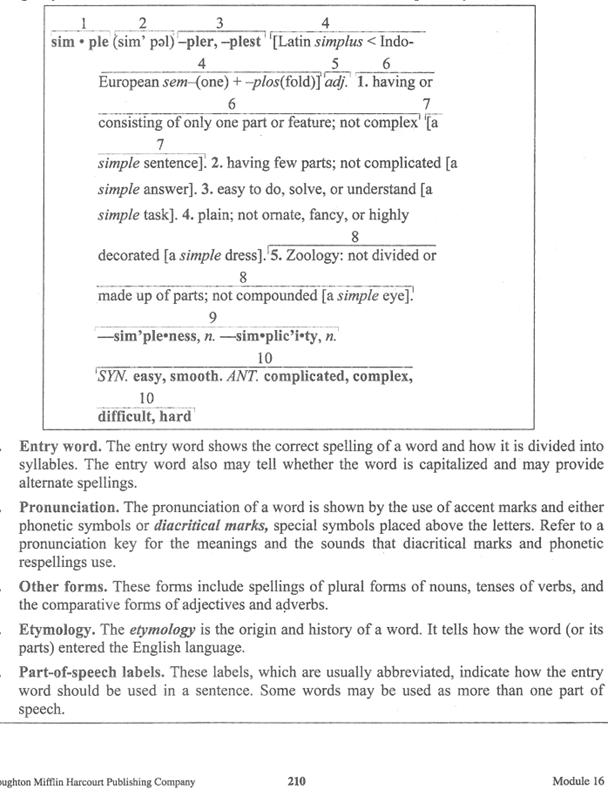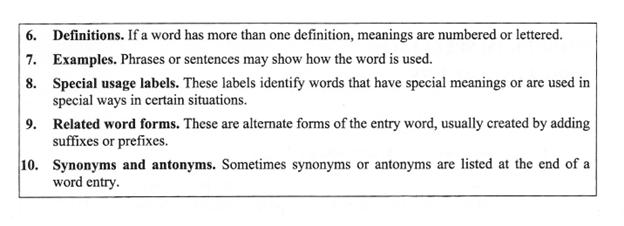Dictionary Entries With Labels
Lynnette Taylor


Dictionary entries are discussed in Section 21, Alphabetical References, in Braille Formats, 2016. Section 21.8 is specifically about dictionaries and discusses the part of the full entry. Depending on the reading level of the dictionary, the entries can be simple or very complex. The example in this discussion has the added complexity of having labels.
The print example has the labels following the dictionary entry. In braille the labels need to be shown first even though, as in this case, the labels are continued on the next print page. To show this properly in braille use combined page numbers and include the change in the explanatory transcriber’s note.
Labels are discussed in Section 16 of Braille Formats and the keying technique is found in Section 16.11. Since are labels are numbered, we do not need to develop a list of key letters. The guidelines say not to use numbers, however, since they are in print, we will use them.
The transcriber’s note should read:
Print has been changed to place the labels before the dictionary entry. Combined page numbers will be used as the labels continue on the following page. In print the numbers appear above the defined part of the dictionary entry. The label number will appear before the beginning of the text to which it applies. Labeled phrases or sentences are enclosed in braille grouping indicators. Items numbered in the entry are in bold.
Note that the transcriber’s note is not exactly as in the guidelines but has been adjusted for this specific example. Also note that since numbers are used in the labels the numbers in the entry should retain the bold to differentiate them.
,:5 Y >E N SURE AB ! #BAJ-#BAA
SPELL+ ( A ^W2 LOOK 9 A DIC;N>Y4 ,A
DIC;N>Y 5TRY C AL GIVE Y M* USE;L 9=MA;N
AB A ^W4 ,"H IS A SAMPLE 5TRY4
@.< ,PR9T HAS BE5 *ANG$ TO PLACE !
LABELS 2F ! DIC;N>Y 5TRY4 ,COMB9$
PAGE NUMB]S W 2 US$ Z ! LABELS 3T9UE
ON ! FOLL[+ PAGE4 ,9 PR9T ! NUMB]S
APPE> ABV ! DEF9$ "P ( ! DIC;N>Y
5TRY4 ,! LABEL NUMB] W APPE> 2F !
2G9N+ ( ! TEXT TO : X APPLIES4
,LABEL$ PHRASES OR S5T;ES >E 5CLOS$
9 BRL GR\P+ 9DICATORS4 ,ITEMS NUMB]$
9 ! 5TRY >E 9 BOLD4
,SYMBOLS US$ 2L3
.=< ,OP5+ BRL GR\P+ 9DICATOR
.=> ,CLOS+ BRL GR\P+ 9DICATOR@.>
#A4 ^1,5TRY ^1^W^'4 ,! 5TRY ^W %[S !
CORRECT SPELL+ ( A ^W & H[ X IS DIVID$
9TO SYLLABLES4 ,! 5TRY ^W AL MAY TELL
:E!R ! ^W IS CAPITALIZ$ & MAY PROVIDE
ALT]NATE SPELL+S4 #A
Lines 5-19: the transcriber’s note explaining the format of the dictionary entry.
Line 21: the beginning of the labels, a list in 1-3.
#B4 ^1,PRONUNCIA;N4 ,! A#BAJ-#BAA
PRONUNCIA;N ( A ^W IS %[N BY ! USE (
A35T M>KS & EI PHONETIC SYMBOLS OR
.1DIACRITICAL .1M>KS1 SPECIAL SYMBOLS
PLAC$ ABV ! LRS4 ,REF] TO A
PRONUNCIA;N KEY = ! M1N+S & ! S.DS T
DIACRITICAL M>KS & PHONETIC RESPELL+S
USE4
444
#AJ4 ^7,SYNONYMS & ANTONYMS4^' ,"S"TS
SYNONYMS OR ANTONYMS >E LI/$ AT ! 5D (
A ^W 5TRY4
SIMPLE ^1#A ;<SIM_4PLE;> #B
;<SIM^.BP_5L;> #C ;<-PLER1 -PLE/;>
#D ;<.<,LAT9 .1SIMPLUS @<
,9DO-,EUROP1N .1SEM-"<"O"> "6 -PLOS
"<FOLD">.>;>
#E ;<ADJ4;>
#F "<#A4 HAV+ OR 3SI/+ ( ONLY "O "P OR
F1TURE2 N COMPLEX;> #G ;<.<A
.1SIMPLE S5T;E.>4;>
^1#B4 HAV+ FEW "PS2 N COMPLICAT$ .<A
.1SIMPLE ANSW].>4
^1#C4 EASY TO D1 SOLVE1 OR "U/& #B
Line 14: beginning of the dictionary entry with the word shown without contractions or divisions. (See 20.6.1a), includes the pronunciation, alternative endings, and derivation.
Line 19: a new line for the part of speech since another part of speech is listed below in the related word forms
.<A .1SIMPLE TASK.>4 B#BAJ-#BAA
^1#D4 PLA92 N ORNATE1 FANCY1 OR HI<LY
DECORAT$ .<A .1SIMPLE DRESS.>4
#H ;<^1#E4 ,ZOOLOGY2 N DIVID$ OR MADE
UP ( "PS2 N COMP.D$ .<A .1SIMPLE
EYE4.>;>
#I ;<,-SIMPLE_4NESS1 ;N4
,-SIM_4PLIC^.BI_4TY1 ;N4;>
#AJ ;<,,SYN4 EASY1 SMOO?4
,,ANT4 COMPLICAT$1 COMPLEX1 DI6ICULT1
H>D;>
Line 4: a new line for the special usage label.
Lines 7-8: related words
Lines 9-11: shows the synonyms and antonyms
Keep in mind that if you break down the problem print format to smaller parts it is easier. Do the entry first so that it is correct and then think about how to insert the labels.
Back to Skills Articles